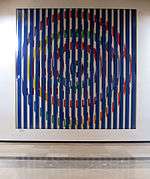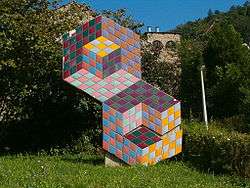Yaacov Agam
| Yaacov Agam | |
|---|---|
|
Yaacov Agam in front of a building he decorated in Tel Baruch, Tel Aviv, Israel | |
| Native name | יעקב אגם |
| Born |
Yaakov Gipstein 11 May 1928 Rishon LeZion, Mandate Palestine |
| Citizenship | Israeli |
| Alma mater | The Bezalel Academy of Art and Design in Jerusalem, the Kunstgewerbe Schule |
| Occupation | Sculptor and experimental artist |
| Known for | Contributions to optical and kinetic art |

Yaacov Agam (Hebrew: יעקב אגם; born 11 May 1928) is an Israeli sculptor and experimental artist best known for his contributions to optical and kinetic art.
Biography
Yaacov Agam was born Yaakov Gibstein in Rishon LeZion, then Mandate Palestine. His father, Yehoshua Gibstein, was a rabbi and a kabbalist.[1]
Agam trained at the Bezalel Academy of Art and Design in Jerusalem, before moving to Zürich, Switzerland in 1949, where he studied under Johannes Itten (1888–1967) at the Kunstgewerbe Schule, and was also influenced by the painter and sculptor Max Bill (1908–1994).
In 1951 Agam went to Paris, France, where he still lives.[2] He has a daughter and two sons, one of whom is the photographer Ron Agam.[3]
Artistic career
Agam's first solo exhibition was at the Galerie Craven, Paris, in 1953,[4] and he exhibited three works at the 1954 Salon des Réalités Nouvelles.[5] He established himself as one of the leading pioneers of kinetic art at the Le Mouvement exhibition at the Galerie Denise René, Paris, in 1955, alongside such artists as Jesús Rafael Soto, Carlos Cruz-Díez, Pol Bury, Alexander Calder and Jean Tinguely.
In 1964, Agam wrote his artistic credo, unchanged since then.
My intention was to create a work of art which would transcend the visible, which cannot be perceived except in stages, with the understanding that it is a partial revelation and not the perpetuation of the existing. My aim is to show what can be seen within the limits of possibility which exists in the midst of coming into being.[6]
Agam's work is usually abstract, kinetic art, with movement, viewer participation and frequent use of light and sound. His works are placed in many public places. His best known pieces include "Double Metamorphosis III" (1965), "Visual Music Orchestration" (1989) and fountains at the La Défense district in Paris (1975) and the "Fire and Water Fountain" in the Dizengoff Square in Tel Aviv (1986). He is also known for a type of print known as an Agamograph, which uses lenticular printing to present radically different images, depending on the angle from which it is viewed. The lenticular technique was executed in large scale in the 30 ft (9.1 m) square "Complex Vision" (1969) which adorns the facade of the Callahan Eye Foundation Hospital in Birmingham, Alabama.[7]
Agam had a retrospective exhibition in Paris at the Musée National d'Art Moderne in 1972, and at the Guggenheim Museum in New York in 1980, among others. His works are held in numerous museum collections including the Museum of Modern Art[8] and the Mildred Lane Kemper Art Museum.[9]
He is the subject of two documentary films by American filmmaker Warren Forma: "Possibilities of Agam" (1967) and "Agam and..." (1980).
In 1996, he was awarded the Jan Amos Comenius Medal by UNESCO for the "Agam Method" for visual education of young children.
He designed and created the winner's trophy for the 1999 Eurovision Song Contest that was held in Jerusalem.
In 2009, at age 81, Agam created a monument for the World Games in Kaohsiung, Taiwan titled "Peaceful Communication with the World". It consists of nine 10m high hexagon pillars positioned in diamond or square formation. The sides of the pillars are painted in different patterns and hues, totaling more than 180 shades. One side of each pillar is also lined to segment the structure into sections, so that children's perception of the pillar will change as they grow, because they will see a different pillar at a different height.[10]
One of Agam's more notable creations is the Hanukkah Menorah at the corner of Fifth Avenue and 59th Street in New York City, sponsored by the Lubavitch Youth Organization. The 32-foot-high, gold colored, 4,000 pound steel structure is recognized by the Guinness Book of World Records as the World's Largest Hanukkah Menorah. It uses real oil lamps, which are lighted every year during Hanukkah with the aid of cherry-picking machines.[11]
In May 2014, Agam's piece "Faith- Visual Pray" was presented to Pope Francis by El Al Israel Airlines' president, David Maimon. The piece included significant symbols of both Jewish and Christian faiths.[12]
Agam is the highest-selling Israeli artist. In a Sotheby's New York auction in November 2009, when his "4 Themes Contrepoint" was sold for $326,500, he said: "This does not amaze me … my prices will go up, in keeping with the history I made in the art world." A year later, his "Growth", an outsize kinetic painting done in oil on a wood panel, which was shown at the 1980 retrospective at the Guggenheim Museum, estimated at $150,000 to $250,000, sold for the record-breaking sum of $698,000.[13]
- Fountain in Dizengoff Square in Tel Aviv
 Work by Agam at the Sheba Medical Center, Israel
Work by Agam at the Sheba Medical Center, Israel Facade of Dan Hotel, Tel Aviv
Facade of Dan Hotel, Tel Aviv Eighteen Levels (1971)
Eighteen Levels (1971)
See also
References
- ↑ "At 80, Yaakov Agam still vibrant with his artwork and other ideas" (PDF). JTA. 5 June 2008. Retrieved 22 December 2010.
- ↑ Avraham Ronen (16 July 1998). "Agam Reconsidered". The Israel Review of Arts and Letters 1996/103. Israel Ministry of Foreign Affairs' website.
- ↑ Haim Handwerker (24 August 2009). "Dusty Memories". Haaretz. Retrieved 22 December 2010.
- ↑ Exhibition at Galerie Craven, Paris, 30 October–12 November 1953. Ragon, p. 33
- ↑ Ragon, p. 7
- ↑ Morris Shapiro (13 October 2010). "Yaacov Agam—21st Century Genius". Park West Gallery. Retrieved 22 December 2010.
- ↑ "Callahan Eye Foundation Hospital". Retrieved 22 December 2010.
- ↑ Yaacov Agam (1975). "Coordination II, Screenprint". The Collection, MOMA. Retrieved 22 December 2010.
- ↑ Yaacov Agam (1974). "Portfolio Suite 3, Screenprint". Mildred Lane Kemper Art Museum. Retrieved 22 December 2010.
- ↑ Jenny W. Hsu (24 February 2009). "Agam Installation Exemplifies Peace for Upcoming Kaohsiung World Games". The Taipei Times. Retrieved 22 December 2010.
- ↑ Pamela Skillings,. "Hanukkah Events In New York City". About.com. Retrieved 22 December 2010.
- ↑ "EXCLUSIVE: Israeli Artist Yaacov Agam Explains Jewish Kinetic Rainbow Painting Presented to Pope Francis". The Algemeiner. 29 May 2014. Retrieved 19 September 2014.
- ↑ Avital Burg (20 December 2010). "Art work by Israel's Yaacov Agam sells for record-breaking sum in N.Y. In an auction organized by Sotheby's, 'Growth' sets a new high for sales price received by any Israeli artist in history". Haaretz. Retrieved 22 December 2010.
Bibliography
- Ragon, Michel (1975). Agam: 54 mots cles pour une lecture polyphonique d'Agam (in French). Paris: Éditions Georges Fall. OCLC 2876738.
- Sayako Aragaki (2007). Agam. Beyond the Visible (3 ed.). Gefen Publishing House, Jerusalem/New York. ISBN 978-965-229-405-0.
- Solomon R. Guggenheim Museum (1980). Homage to Yaacov Agam. Solomon R. Guggenheim Museum exhibition. Leon Amiel, New York. ISBN 978-0-8148-0751-4.
- Frank Popper (1968). Origins and Development of Kinetic Art. Studio Vista and New York Graphic Society.
- Frank Popper (1990). Yaacov Agam (3 ed.). H.N. Abrams, New York. ISBN 978-0-8109-1897-9.
External links
| Wikimedia Commons has media related to Yaacov Agam. |
- Works by or about Yaacov Agam in libraries (WorldCat catalog)
- "Yaacov Agam's Bio". Yaacov Agam's Fine Art.
- Park West Gallery Artist Profile: Yaacov Agam on YouTube
- Avraham Ronen (16 July 1998). "Agam Reconsidered". The Israel Review of Arts and Letters 1996/103. Israel Ministry of Foreign Affairs' website.
- Yaacov Agam in American public collections, on the French Sculpture Census website

